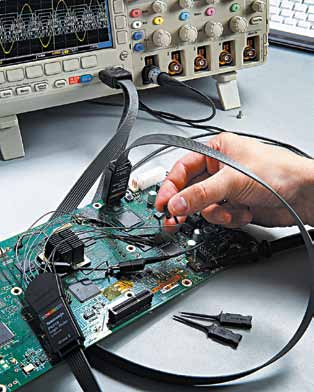As electronic products achieve even higher performance, their increasing complexity makes it harder to design, verify and debug. During the extensive verification that is performed to pick up problems, the ability to simultaneously observe and analyse both the analogue as well as digital signal representations is bliss. This article analyses the recent advancements in mixed-signal oscilloscopes and tells you what you are missing
Dilin Anand

While today’s embedded design engineers are faced with the challenge of ever-increasing system complexity, there are engineers out there who have already started analysing and providing solutions to make sure that the engineers are not inhibited by this complexity.
“Debugging the hardware is a difficult and somewhat daunting task to the engineer who is armed with his favourite four-channel oscilloscope. Many engineers are comfortable with their oscilloscope, and in order to save time, may choose to buy three or four oscilloscopes so that they can probe multiple signals at once. Logic analysers provide the ability to probe multiple digital signals, but the complexity of the debug task may not merit the setup and learning curve required to use the logic analyser,” says Saivenkat Kumar, country marcomm (EMEA marketing), Tektronix.
Logic analysers and oscilloscopes have co-existed for decades, finally giving birth to mixed-signal oscilloscopes (MSOs). Once a niche product category pioneered by HP (now Agilent Technologies), MSOs are now offered by all major scope vendors.
“In old days test engineers were using two sets of instruments—basically an oscilloscope to check the analogue characteristics such as frequency, rise time and fall time of a signal, and logic analysers for digital characterisation. But now with more of mixed-signal designs and also for FPGAs and microcontrollers, MSO is the preferred choice. With two or four analogue channels and up to 16 digital channels, a user can do both analogue and digital characterisation from the same instrument. This saves the cost as well as the time to set up multiple instruments, and also makes it easy to use,” explains Sadaf Arif Siddiqui, marketing programme manager, Agilent Technologies.
High-resolution and larger displays
Mixed-signal oscilloscopes being visual tools, a larger and higher-resolution screen makes them better—unless there is a portability requirement. Utilising the latest display technologies available, vendors have packed better displays into their instruments. Thus with the ability to view more, engineers can spot jitters and infrequent events quicker than in a lower-resolution display.
“Designers are often interested to capture smallest pulse widths of their embedded designs. The smallest pulse widths that can be detected depend on the sampling rate and the detection architecture. Mixed-signal oscilloscopes can capture pulse width of minimum 200 ps due to a high resolution of 200 ps,” explains Srinivasa Appalla, area manager-product support & applications, test & measurement, at Rohde & Schwarz.
[stextbox id=”info”]Designers are often interested to capture smallest pulse widths of their embedded designs. This depends on the sampling rate and detection architecture —Srinivasa Appalla, area manager-product support & applications, test & measurement, Rohde & Schwarz[/stextbox]
[stextbox id=”info”]In the latest oscilloscopes, a mere software licence key is all that is required to go from a DSO to a MSO —Sadaf Arif Siddiqui, marketing programme manager, Agilent Technologies[/stextbox]
This is one of the most common trends seen amongst the latest instruments—Tektronix and Agilent MSOs also feature XGA resolution.
Targeting the education sector
The requirement of the education sector is different from the rest of the industry’s. The education sector requires equipment that are inexpensive and reliable, and cater to the changing requirements of students as the syllabus changes.
J.K. Baldua, director-technical at Scientech Indore, explains, “Change in the educational syllabus is an ongoing process, and because of this the university reframes the list of experiments. We have the instruments catering to these experiments.”
Apart from the instruments for lab work, universities and colleges have also started procuring instruments for field work by students. One example of such instruments is the Scientech 700 series, which is an extremely compact MSO that does not sacrifice much in terms of features.
“While the regular lab work requires benchtop instruments, field experiments conducted by the students and project testing require portable, compact and easy-to-handle instruments. All this, and an inexpensive price tag, attract the education sector,” adds Baldua.
Protocol analysis
Embedded design engineers commonly use serial protocols such as I2C and SPI to simplify communication between system blocks on a circuit board. While these serial protocols can reduce wiring complexity, debugging their implementation is cumbersome with traditional oscilloscopes.






